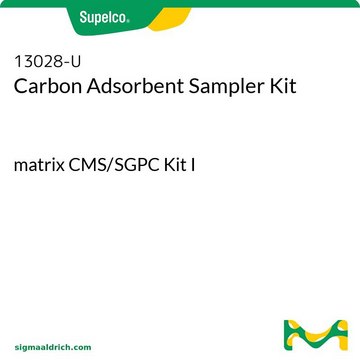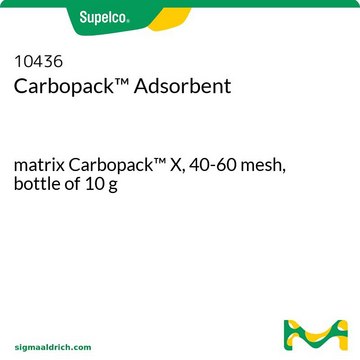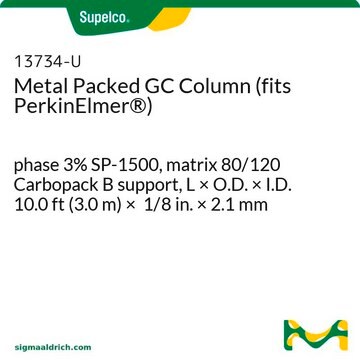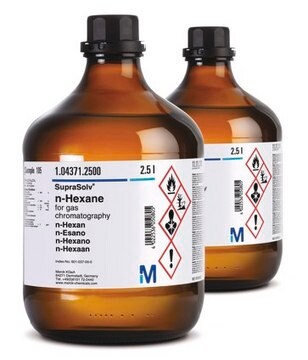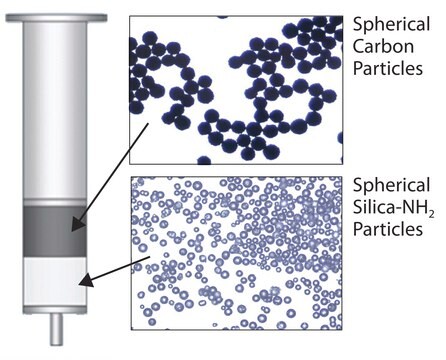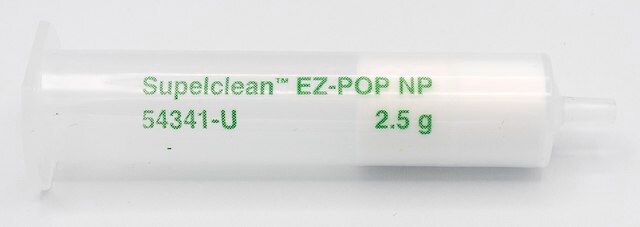11021-U
Graphsphere™ Carbon Adsorbent
matrix Graphsphere™ 2016, 60-80 mesh, bottle of 10 g
Synonyme(s) :
polymeric adsorbent, FormerlyCarboxen® 1016, 60-80 mesh
About This Item
Produits recommandés
product name
Graphsphere™ Adsorbent, matrix Graphsphere™ 2016, 60-80 mesh, bottle of 10 g
Description
Formally Carboxen® 1016
Gamme de produits
Carboxen®
Graphsphere™
Forme
powder
Conditionnement
bottle of 10 g
Technique(s)
LPLC: suitable
Superficie
~75 m2/g
Matrice
Formally Carboxen® 1016
Graphsphere™ 2016
Groupe de la matrice active
carbon
Taille des particules
60-80 mesh
Dimension de pores
~0.34 cm3/g mesoporosity
~0 cm3/g macroporosity
~0 cm3/g microporosity
~0 Å pore diameter
Densité
~0.41 g/mL (free fall density)
Application(s)
sample preparation
Technique de séparation
reversed phase
Catégories apparentées
Description générale
- Spherical (better packed bed performance than granular particles)
- Hard and non-friable (pack well, will not break)
- Used for molecules with an analyte size relative to C5-C12 n-alkanes
- Hydrophobic (can be used in high humidity environments)
Generally, SGPC adsorbents offer weaker relative adsorptive strength compared to carbon molecular sieve (CMS) adsorbents, and similar relative adsorptive strength compared to graphitized carbon black (GCB) adsorbents. Our Graphsphere™ products are a type of SGPC adsorbent. They are great alternatives to GCB adsorbents (which are granular and friable).
For more information about any of our specialty carbon adsorbents, please visit sigma-aldrich.com/carbon
Informations légales
Code de la classe de stockage
11 - Combustible Solids
Classe de danger pour l'eau (WGK)
nwg
Point d'éclair (°F)
Not applicable
Point d'éclair (°C)
Not applicable
Faites votre choix parmi les versions les plus récentes :
Certificats d'analyse (COA)
Désolés, nous n'avons pas de COA pour ce produit disponible en ligne pour le moment.
Si vous avez besoin d'assistance, veuillez contacter Service Clients
Déjà en possession de ce produit ?
Retrouvez la documentation relative aux produits que vous avez récemment achetés dans la Bibliothèque de documents.
Les clients ont également consulté
Articles
Carbon Molecular sieves (CMS) are a versatile range of adsorbents that can be tailored for specific applications. Supelco® scientists have been synthesizing synthetic CMS carbons for several decades, starting from tailoring of the starting polymers/copolymers, to modifying the final properties of the subsequent CMS carbon.
Notre équipe de scientifiques dispose d'une expérience dans tous les secteurs de la recherche, notamment en sciences de la vie, science des matériaux, synthèse chimique, chromatographie, analyse et dans de nombreux autres domaines..
Contacter notre Service technique
